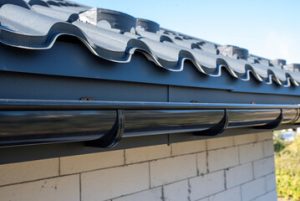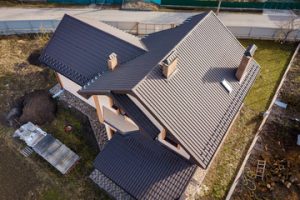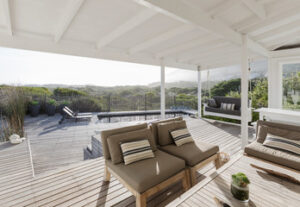Gutters Gainesville FL are half-pipes that help direct rainwater away from your home. They prevent soil erosion, eliminate water damage to your siding, stop leaks in basements and crawl spaces, and preserve the structural integrity of your foundation.

Look for a gutter installation company that has extensive experience and a history of customer satisfaction. A reputable company will be transparent about their timelines and costs.
A well-functioning gutter system protects the integrity of a home, preventing costly water damage and protecting the sanctity of indoor spaces. Gutters channel rainwater away from the house, preventing problems such as roof leaks and foundation cracks. However, gutters need to be properly maintained and inspected to ensure that they’re working as intended. A poorly functioning gutter system is a recipe for disaster, especially during our region’s heavy seasonal rainfall and freeze-thaw cycles.
Without gutters, rainwater flows off the roof and down to the ground, where it can pool around the foundation or seep into basements. Gutters prevent this by collecting the water before it reaches the ground, directing it downhill and away from the property. If the gutters are clogged or damaged, the water will overflow to the siding and back up onto the roof. This can cause extensive damage to the fascia, soffit, and shingles, as well as water intrusion into the house itself.
Gutter systems also direct the water into downspouts, which carry the moisture away from the foundation of the home. However, if downspouts are too short or improperly positioned, the water can still build up next to the foundation and flood the basement. Downspout placement is crucial for effective drainage, and our experts can recommend the right solution for your home.
When the gutters are functioning properly, they also prevent mold and mildew growth by diverting the excess moisture away from the structure. This helps maintain a drier environment that’s hostile to the growth of these fungi, which can also affect indoor air quality and lead to health issues.
Our gutter solutions are tailored to the unique challenges of homes in the New York, New Jersey, and Connecticut regions. Our gutters are designed to channel water away from the house effectively, safeguarding against both leaky basements and foundation cracks. We can help you spot early warning signs of an impending problem, such as water stains on ceilings or peeling paint, so you can take action before the damage escalates. Contact us today to learn how we can protect your home with a high-performance gutter system.
Prevent Structural Damage
Gutters channel the water that lands on your roof and downspouts, safely away from your home’s foundation. Without gutters, water can pool around the base of your house, causing soil erosion and basement flooding. Additionally, excessive moisture can damage the soffit, fascia, and shingles of your roof.
In addition to preventing structural damage, proper gutter installation also extends the lifespan of your roof. Clogged gutters prevent water from flowing properly off your roof, leading to rot, mold growth, and leaks. Regular cleaning of your gutters keeps them clear of leaves, dirt, and debris, reducing their likelihood of clogging.
Proper gutter installation begins with a thorough assessment of your roofline and drainage needs. Gutters should be sloped correctly to ensure that the water they collect flows downhill and away from your house. Additionally, they should be installed with downspout extensions or splash blocks to ensure that your foundation is protected from water intrusion.
Poor gutter installation can be just as damaging as no gutters at all. Gutters that are not sloped correctly or have faulty fasteners can cause them to become detached from the fascia board, resulting in water overflow and damage to your roof. Additionally, gutters that are not securely attached to the fascia board can become sagging and affect the overall appearance of your home.
Gutter cleaning is one of the most important steps in protecting your home from water damage, especially in Florida. Heavy rains and humidity can quickly clog your gutters, leaving them vulnerable to leaks, mold growth, and foundation problems. In addition to regular gutter cleaning, proper maintenance includes trimming overhanging branches that can fall into the gutters and contribute to clogs, as well as repairing gutter seams that are showing signs of wear.
Prevent Soil Erosion
Rain gutters are important for preventing soil erosion around your home. Without gutters, rainwater can pool and wash away the soil around your foundation, displacing it and creating an unstable environment for your home. Gutters collect rainwater and direct it into a designated drainage system, which prevents soil erosion while protecting your home’s foundation and landscaping.
A well-functioning gutter system can also protect your home’s siding and windows from moisture damage. Moisture that seeps into gaps around window and door frames can lead to rot, mold growth, and paint peeling. Gutter systems that properly direct rainwater away from your home can help reduce the risk of moisture damage and extend the lifespan of your siding and windows.
Clogged gutters, however, can impede the effectiveness of your gutter system and cause water to overflow during storms. Even the best gutters can become clogged with leaves, twigs, pine needles, sediment, and other debris over time. Routine cleaning helps minimize the buildup of these materials, allowing water to flow freely and keeping your gutter system functioning properly.
Without a functioning gutter system, water can overflow from the gutters and flood your landscape or basement. Overflowing water can also erode the soil under your home’s foundation, causing cracks and shifting of the structure’s foundation over time. Gutters effectively manage the flow of water and keep water away from your home’s foundation, helping to protect your investment in landscaping and your property value.
Gutters also help stabilize soil by distributing water evenly throughout your yard and flower beds. This can help preserve your landscaping and save you money on expensive repairs to your outdoor features. If you’re interested in preventing soil erosion around your home, contact the experienced gutter experts at North Texas Gutters. We can install new gutters to better serve your needs, or we can help alter your existing gutter system for improved performance. We have extensive experience with the local weather patterns, soil composition, and neighborhood drainage patterns across Splendora, Willis, Krum, and the surrounding areas. We understand the unique challenges of each area and can design a customized drainage solution to meet your specific needs.
Add Curb Appeal
A property’s curb appeal is a first impression that can impact how visitors, passersby, and potential buyers perceive the structure. Investing in curb appeal is an important element of maintaining property value. Homeowners usually consider factors like a fresh coat of paint, well-kept landscaping, and attractive window shutters when looking for ways to boost their home’s aesthetics. However, a gutter upgrade may be an underrated way to improve a house’s visual appeal.
Gutters not only make the roof look better but also protect outdoor features from water damage. They can prevent sagging, staining, and damage to flower beds, walkways, and driveways by keeping rainwater away from these areas. They can also keep wood and siding from rotting, which could result in costly repairs. In addition, they can help protect structural elements by preventing water from pooling around the foundation, which can cause cracks and soil erosion.
The most obvious benefit of installing new gutters is that they provide a cleaner, more polished appearance for the home. This is especially true for seamless gutters, which feature a smooth, streamlined profile that blends in with the architecture of a building. They can be crafted from a variety of materials to complement different styles of homes, including aluminum and copper. The color of a gutter can also play a role in its aesthetics. Gutter colors that match or closely resemble the siding or trim color of a home create a cohesive, uniform appearance. Gutters that are a contrasting color, on the other hand, can add a bold accent to the home’s architectural features.
Aside from adding a pop of color and a clean, refined appearance, gutters can also increase a home’s resale value. Having a gutter system that is well-maintained and functional will indicate to potential buyers that the home has been cared for over the years. This can be an attractive selling point, particularly in today’s challenging economy, when potential homeowners are often looking for a stress-free, low-maintenance living space. For example, gutters with built-in leaf catchers and screen filters are an attractive feature for people who want to avoid the hassle of annual maintenance.




